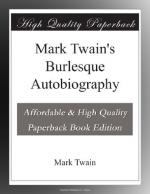And truly, never was there seen a more brilliant chivalry than that collected round the gallant Prince Henry! There was not a man in his army but had lacquered boots and fresh white kid-gloves at morning and evening parade. The fantastic and effeminate but brave and faithful troops were numbered off into different legions: there was the Fleur-d’Orange regiment; the Eau-de-Rose battalion; the Violet-Pomatum volunteers; the Eau-de-Cologne cavalry—according to the different scents which they affected. Most of the warriors wore lace ruffles; all powder and pigtails, as in the real days of chivalry. A band of heavy dragoons under the command of Count Alfred de Horsay made themselves conspicuous for their discipline, cruelty, and the admirable cut of their coats; and with these celebrated horsemen came from England the illustrious Duke of Jenkins with his superb footmen. They were all six feet high. They all wore bouquets of the richest flowers: they wore bags, their hair slightly powdered, brilliant shoulder-knots, and cocked-hats laced with gold. They wore the tight knee-pantaloon of velveteen peculiar to this portion of the British infantry: and their legs were so superb, that the Duke of Bordeaux, embracing with tears their admirable leader on parade, said, “Jenkins, France never saw such calves until now.” The weapon of this tremendous militia was an immense club or cane, reaching from the sole of the foot to the nose, and heavily mounted with gold. Nothing could stand before this terrific weapon, and the breast-plates and plumed morions of the French cuirassiers would have been undoubtedly crushed beneath them, had they ever met in mortal combat. Between this part of the Prince’s forces and the Irish auxiliaries there was a deadly animosity. Alas, there always is such in camps! The sons of Albion had not forgotten the day when the children of Erin had been subject to their devastating sway.
The uniform of the latter was various—the rich stuff called corps-du-roy (worn by Coeur de Lion at Agincourt) formed their lower habiliments for the most part: the national frieze* yielded them tail-coats. The latter was generally torn in a fantastic manner at the elbows, skirts, and collars, and fastened with every variety of button, tape, and string. Their weapons were the caubeen, the alpeen, and the doodeen of the country—the latter a short but dreadful weapon of offence. At the demise of the venerable Theobald Mathew, the nation had laid aside its habit of temperance, and universal intoxication betokened their grief; it became afterwards their constant habit. Thus do men ever return to the haunts of their childhood: such a power has fond memory over us! The leaders of this host seem to have been, however, an effeminate race; they are represented by contemporary historians as being passionately fond of flying kites. Others say they went into battle armed with “bills,” no doubt rude weapons; for it is stated that foreigners could never be got to accept them in lieu of their own arms. The Princes of Mayo, Donegal, and Connemara, marched by the side of their young and royal chieftain, the Prince of Ballybunion, fourth son of Daniel the First, King of the Emerald Isle.




